The Collared Kingfisher (Todiramphus chloris) is a magnificent avian species renowned for its vibrant plumage.
As one of the most recognizable and widespread kingfisher species, the Collared Kingfisher is captivating with its striking appearance and charismatic presence in diverse ecosystems across the tropics.
With its azure-blue back, pristine white underparts, and distinctive collar marking, the Collared Kingfisher stands as a beacon of coastal beauty, often observed perched on mangrove branches or swooping gracefully over shimmering waters in search of prey.
Its melodious calls echo through the coastal landscapes, adding a touch of enchantment to the seaside ambiance.
Join us on a journey to uncover the fascinating world of the Collared Kingfisher as we delve into its habitat preferences, hunting techniques, and ecological significance.
Through its elegant presence and graceful demeanor, the Collared Kingfisher invites us to explore the wonders of coastal ecosystems and appreciate the harmony of nature’s symphony.
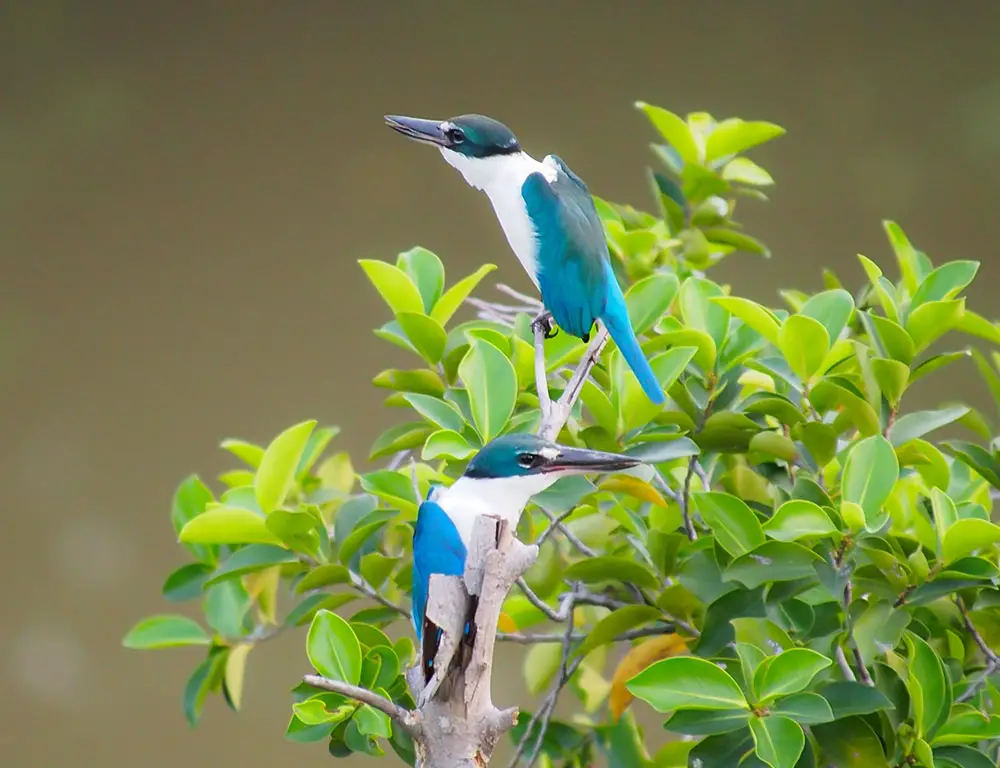
Key Identifying Characteristics of the Collared Kingfisher
The Collared Kingfisher is a stunning bird species found in various coastal and inland habitats across its wide range, which includes parts of Asia, Australia, and the Pacific Islands.
Recognizable by its striking plumage and distinctive features, the Collared Kingfisher possesses several key identifying characteristics:
Size and Shape
The Collared Kingfisher is a medium-sized bird, measuring around 22 to 29 centimeters (9 to 11 inches) in length. It has a stocky build with a large head, short neck, and sturdy, slightly curved, and pointed bill, ideal for capturing prey.
Plumage
One of the most striking features of the Collared Kingfisher is its vibrant plumage. The upperparts are predominantly azure-blue, while the underparts are white with a contrasting orangey-buff wash on the breast and sides. A distinctive black collar encircles the neck, giving the bird its name.
The wings and tail are also blue, with white spots and bars adding to the pattern.
Head and Facial Features
The head of the Collared Kingfisher is large and slightly flattened, with a short, stout bill. The crown and nape are blue, blending seamlessly with the back, while the cheeks and throat are white.
A dark, narrow stripe extends from the bill through the eye and down the sides of the neck, further accentuating its facial features.
Tail
The tail of the Collared Kingfisher is short and square-tipped, with a blue coloration similar to the wings. It may exhibit white spots or bars, particularly on the outer tail feathers, adding to its distinctive appearance.
Flight Pattern
The Collared Kingfisher displays a characteristic undulating flight pattern in flight, with rapid wingbeats interspersed with short glides. Its broad and rounded wings provide stability and agility during aerial pursuits of prey.
Voice
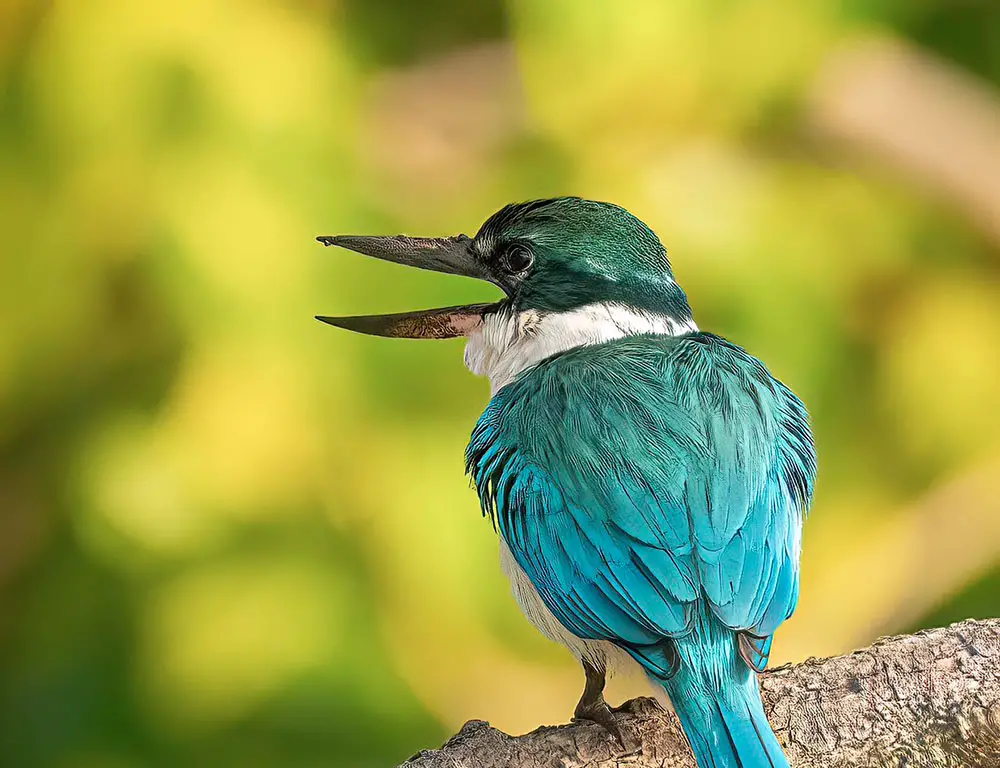
The call of the Collared Kingfisher is a distinctive, far-carrying series of musical notes, often described as a loud “kek-kek-kek” or “kee-kee-kee-kee.”
Males and females may engage in duets, especially during the breeding season, adding to the ambiance of coastal and inland habitats where they reside.
Habitat Preference
Collared Kingfishers are commonly found in various habitats, including mangroves, coastal forests, riverbanks, wetlands, and even urban areas with suitable vegetation and water bodies.
They are particularly associated with water bodies such as estuaries, tidal flats, and ponds, where they hunt for fish, crustaceans, and other aquatic prey.
Geographic Distribution
The Collared Kingfisher has a wide geographic distribution, ranging from parts of Asia, including India, Southeast Asia, and China, to Australia, New Guinea, and various Pacific Islands.
Different subspecies may exhibit slight variations in plumage coloration and pattern within its range.
Behavior
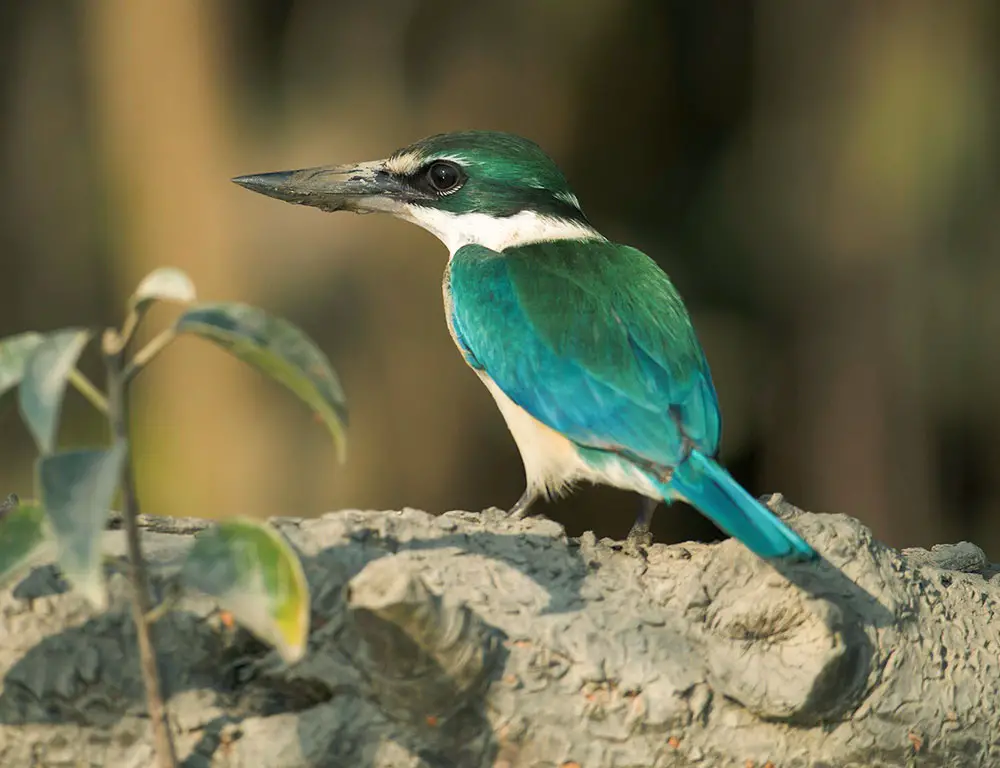
Collared Kingfishers are primarily solitary birds, often seen perched on exposed branches or wires near water bodies, patiently scanning for prey. They are adept hunters, using their keen eyesight to spot potential prey before diving swiftly to capture it with their sharp bills.
Breeding and Nesting
During breeding, Collared Kingfishers form monogamous pairs and establish territories in suitable nesting sites, such as natural tree hollows or artificial structures.
They may excavate nesting burrows in riverbanks or sandy substrates, where the female lays a clutch of eggs and both parents share incubation and chick-rearing duties.
Taxonomic Level and Life History of the Collared Kingfisher
Understanding the taxonomic classification and life history of the Collared Kingfisher provides valuable insights into its ecology, behavior, and conservation needs, aiding efforts to protect this charismatic bird species and its habitat.
Taxonomy
| Taxonomy Level | Classification |
| Kingdom | Animalia |
| Phylum | Chordata |
| Class | Aves |
| Order | Coraciiformes |
| Family | Alcedinidae |
| Genus | Todiramphus |
| Species | Todiramphus chloris |
Range Map
The range map illustrates the distribution of the Collared Kingfisher across its habitat range, including parts of Asia, Australia, and the Pacific Islands.
It highlights where these birds are commonly found, such as coastal regions, mangroves, riverbanks, and wetlands, providing valuable insight into their geographic distribution and ecological preferences.
Food Habits
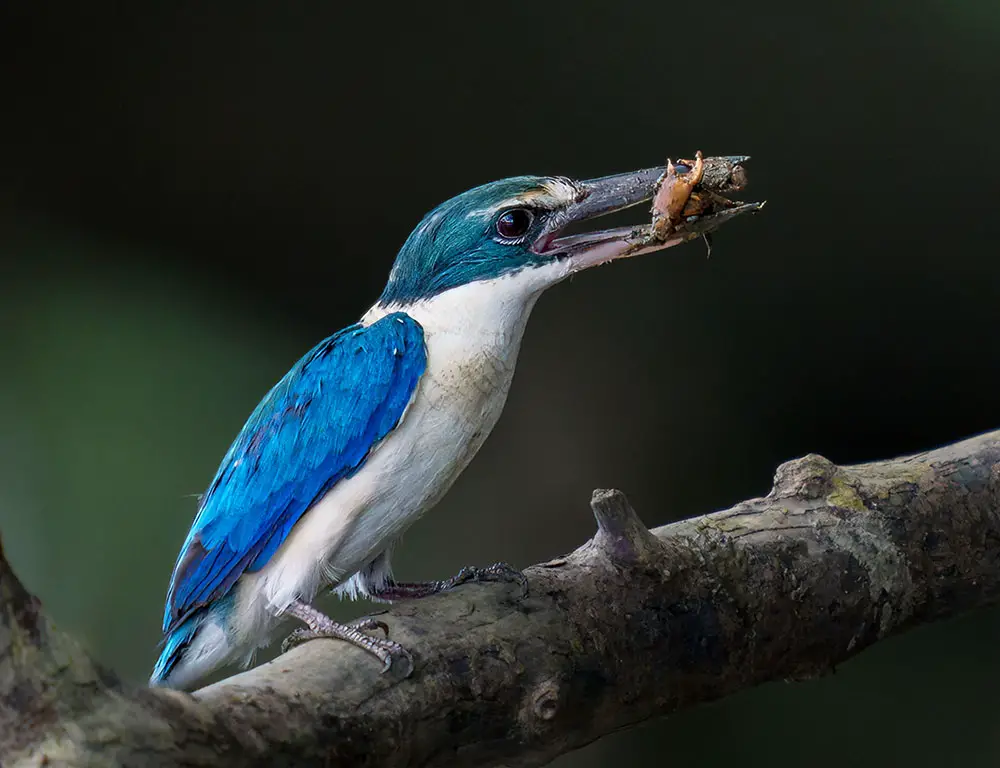
Collared Kingfishers primarily feed on a diet of fish, crustaceans, insects, and occasionally small vertebrates. They are adept hunters, using their sharp bills to catch prey both above and below the water’s surface.
They often perch on branches or other elevated positions near water bodies, scanning for movement before diving swiftly to capture prey.
Nesting
| Nesting Habit | Description |
| Nest Location | Natural tree hollows, riverbanks, or sandy substrates |
| Nest Composition | Excavated nesting burrows or natural cavities |
| Clutch Size | Typically contains 3-5 eggs |
| Incubation Period | Around 19-21 days |
| Parental Care | Both males and females share incubation and care |
Breeding
Collared Kingfishers form monogamous pairs during the breeding season. They establish territories and construct nests in suitable locations, such as natural tree hollows or excavated burrows in riverbanks.
The female lays a clutch of eggs, and both parents share incubation and chick-rearing duties until the young fledge from the nest.
Conservation Status
The Collared Kingfisher is not globally threatened and is considered of most minor concern by the International Union for Conservation of Nature (IUCN).
However, localized threats such as habitat loss, pollution, and disturbance to nesting sites may impact populations in certain areas.
Diseases and Treatments
Collared Kingfishers may be susceptible to various avian diseases, including respiratory infections, parasitic infestations, and injuries.
Treatment typically involves veterinary care, including antibiotics, antiparasitic medications, and supportive therapy to aid recovery.
7 Fun Facts About the Collared Kingfisher
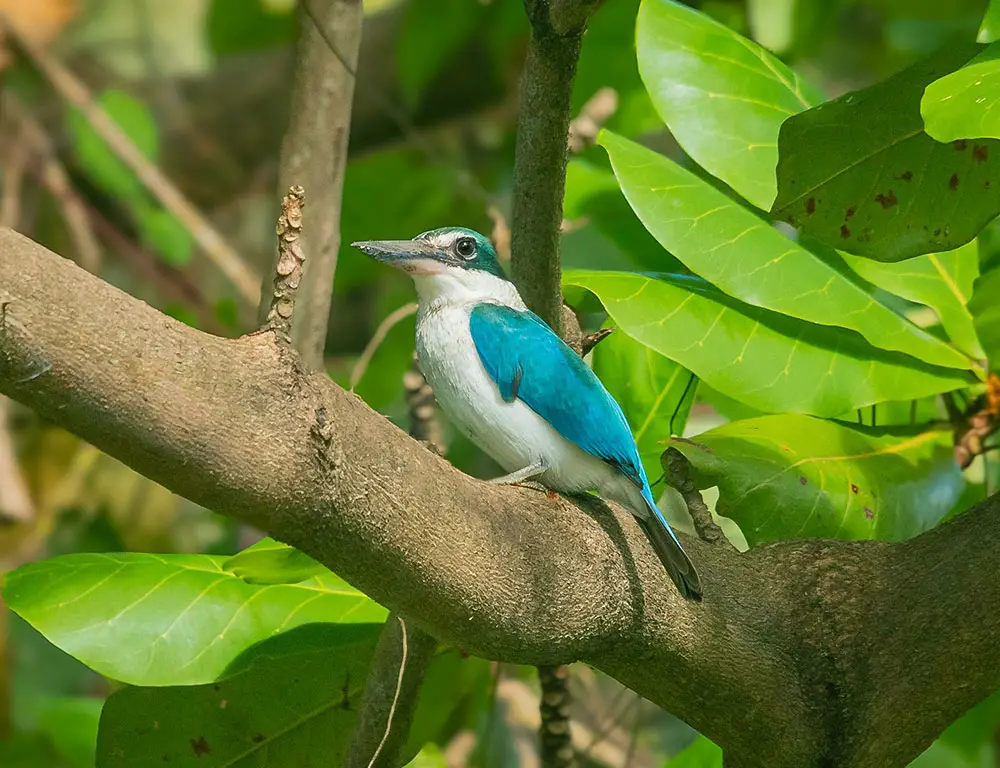
Here, we’ll discover some fascinating insights into the life of the Collared Kingfisher:
1. Expert Fisher
The Collared Kingfisher is a skilled hunter, capable of catching fish precisely. It perches patiently near water bodies, then dives swiftly to snatch its prey with its sharp bill.
2. Vibrant Plumage
With its azure-blue back, pristine white underparts, and striking black collar, the Collared Kingfisher boasts a dazzling array of colors that make it a sight to behold.
3. Wide Geographic Range
Found across parts of Asia, Australia, and the Pacific Islands, the Collared Kingfisher has adapted to various habitats, from coastal mangroves to inland rivers.
4. Distinctive Call
The call of the Collared Kingfisher is a loud, melodious series of notes, often described as a rhythmic “kek-kek-kek” or “kee-kee-kee-kee,” adding to the ambiance of its habitat.
5. Monogamous Pairing
During the breeding season, Collared Kingfishers form monogamous pairs and establish territories where they construct nests and raise their young together.
6. Excavated Nests
Collared Kingfishers often excavate nesting burrows in riverbanks or sandy substrates, where the female lays a clutch of eggs, and both parents share incubation and chick-rearing duties.
7. Adaptable Predators
In addition to fish, Collared Kingfishers also prey on crustaceans, insects, and small vertebrates, showcasing their adaptability as opportunistic hunters in varied environments.
FAQs
What is a Collared Kingfisher?
The Collared Kingfisher (Todiramphus chloris) is a bird species known for its vibrant plumage and adept hunting skills near water bodies. It belongs to the family Alcedinidae and is commonly found in coastal regions across Asia, Australia, and the Pacific Islands.
What does a Collared Kingfisher eat?
Collared Kingfishers primarily feed on a diet of fish, crustaceans, insects, and occasionally small vertebrates. They are skilled hunters, perching near water bodies and diving swiftly with their sharp bills to catch prey.
Where does the Collared Kingfisher live?
Collared Kingfishers inhabit various habitats, including coastal mangroves, riverbanks, wetlands, and even urban areas with suitable vegetation and water bodies. They are commonly found across Asia, Australia, and the Pacific Islands.
Is the Collared Kingfisher endangered?
The Collared Kingfisher is not globally threatened and is considered of most minor concern by the International Union for Conservation of Nature (IUCN).
However, localized threats such as habitat loss, pollution, and disturbance to nesting sites may impact populations in certain areas.
How does the Collared Kingfisher catch prey?
Collared Kingfishers are expert hunters, using a sit-and-wait strategy near water bodies. They perch on branches or other elevated positions, then dive swiftly to snatch prey, such as fish or crustaceans, with sharp bills.
Conclusion
The Collared Kingfisher is a testament to the beauty and resilience of coastal avian species. Its azure-blue plumage and melodious calls adorn the tropical landscapes, enriching our experiences with the sights and sounds of coastal ecosystems.
As a skilled hunter and adept fisher, the Collared Kingfisher plays a vital role in maintaining the delicate balance of these habitats, contributing to the biodiversity and ecological health of coastal regions.
Through conservation efforts to preserve coastal habitats and mitigate human impacts, we can ensure the continued survival of the Collared Kingfisher and other coastal species.
By protecting their nesting sites, safeguarding their foraging grounds, and promoting sustainable practices, we can uphold the natural heritage of these majestic birds for future generations to admire and cherish.
Let us unite in our commitment to conservation and stewardship, honoring the Collared Kingfisher as a coastal beauty and resilience symbol.